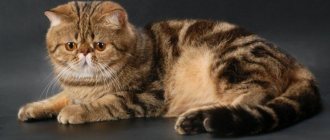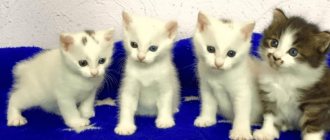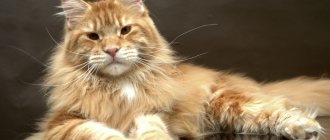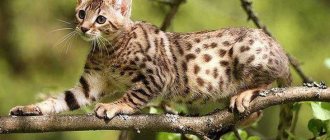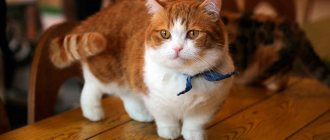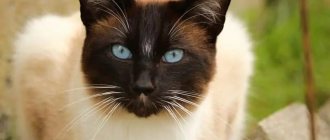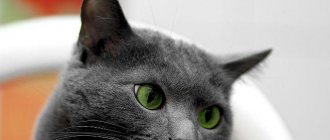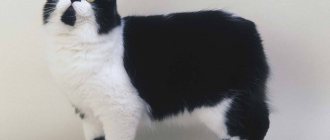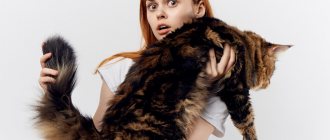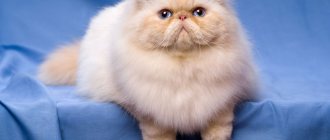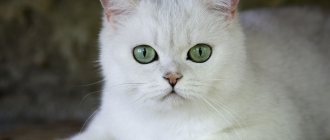Cat breeds with a flattened face and large eyes
Brachycephaly is a shortened longitudinal diameter of the skull. These cats have a spherical head shape.
There are not many brachycephalic cats registered in felinological organizations. They all have a similar skull structure, but differ from each other in body type, coat length and character.
The most popular among existing breeds of cats with a flattened face are:
- Persian cat;
- exotic;
- Himalayan cat;
- British Shorthair;
- Scottish fold cats;
- wild cat manul.
Persian cat
These fluffy animals with a flattened nose appeared several centuries ago and have not lost popularity since then. They are quite large in size - some individuals can weigh up to 7 kg.
Purebred Persians are easily recognized by their squat body with short legs and unusual flat muzzle with large, expressive eyes. The compact body of snub-nosed cats is covered with luxurious fur, the length of which can reach 12 cm.
Depending on the structure of the skull, the following types are distinguished in the breed:
- classic - with the nose located below eye level;
- modern - with a lobe located in line with the lower eyelid;
- extreme - with a concave nose located level with the inner corners of the eyes.
In addition to its attractive appearance, this cat with a flattened muzzle and large eyes is endowed with a balanced, gentle disposition. True, sometimes the truly royal calm of representatives of the breed can give way to demands and whims.
The snub-nosed Persian prefers to spend most of his time on a soft sofa. So owners of these luxurious, flat-faced cats won't have to worry about tattered curtains or scratched furniture.
Exotic
This flat-faced cat is closely related to Persians and American Shorthairs. It was developed in the United States in the 1960s and quickly achieved breed status. The plush cats with a flattened face were originally called Sterlings, but were later renamed Exotic Shorthairs.
Snub-nosed cats are relatively large in size and weigh up to 7 kg. The distinctive hallmark of the breed is its small, forward-pointing ears, pronounced cheeks and huge, wide-set eyes.
Compact, tightly knit exotics are covered with short, silky, two-layer coat of almost any color.
Squat cats with a flattened muzzle and large eyes are distinguished by a calm and peaceful disposition. Playful and friendly representatives of the breed never show aggression or make unnecessary noise. Snub-nosed cats quickly become attached to their owners and get along with other pets without problems.
Himalayan cat
These owners of a flattened muzzle and large eyes were the result of crossing representatives of the Persian and Siamese breeds. To date, Himalayan cats are not recognized by all felinological organizations. In some associations, kittens of this breed are registered as Persian.
From both ancestors, Himalayan cats took only the best features:
- from the Persians they inherited a flattened nose and luxurious long hair;
- from the Siamese they got blue eyes and a beautiful color-point color.
Snub-nosed Himalayan cats are endowed not only with an interesting appearance, but also with a wonderful character. Representatives of the breed are distinguished by a calm, affectionate and slightly lazy disposition. These fluffy cats with large eyes and a flattened muzzle get along well with children and are patient with all their pranks.
British Shorthair
The name of this popular and widespread breed is known even to those who are far from the world of felinology. The British Shorthair is easily recognized by its rounded, flattened muzzle, large expressive eyes and squat body covered with plush fur of different colors.
These attractive snub-nosed cats are endowed with a balanced and flexible disposition. Neat and intelligent representatives of the breed tolerate loneliness well and lend themselves well to education.
Short-haired cats with large eyes and a flattened muzzle have simply limitless patience and rarely release their claws.
Scottish fold cats
Representatives of this breed are endowed with an unusual appearance. Their main distinguishing feature is their ears that are tilted forward and downward. The closer their tips are in contact with the surface of the head, the more valuable the animal is considered.
The snub-nosed Scottish cat has a moderately flattened muzzle and a powerful body covered with thick, soft hair of different colors.
On a note. The straight-eared Scotsman is called the Scottish Straight. It is used in breeding along with lop-eared representatives of the breed to reduce the risk of sick offspring.
Unpretentious Scots are endowed with a balanced and calm disposition. Representatives of the breed are distinguished by their playful character and high intelligence. These peaceful cats with a flattened muzzle, curled ears and large eyes get along well with children and do not like to be left alone.
Wild cat manul
These representatives of the cat family live in Central Asia. They are considered rare and are included in the Red Book.
The large body of the Pallas cat is covered with thick striped fur. And the flattened shape of the muzzle allows you to breathe through the mouth without weakening the grip of the jaws and without releasing prey from the teeth.
The history of flat-faced cats
The domestication of cats occurred about 12 thousand years ago. Back then they were wild animals living in natural conditions. A variety of breeds have begun to appear in the last few centuries. Felinologists were guided by their own vision and created cats with a diverse body structure and coat color.
Cats with a flattened face appeared around 500 BC , at least this fact is attested in written sources and wall paintings. Dutch travelers recorded in their notes that they saw strange cats with fluffy fur at the court of the kings of Persia Cambyses and Darius.
Their attractive appearance made these cats favorites of kings and court nobility . The ancestors of the Persians appeared in Europe in the 16th century. and became loved by the cats of kings. Here cats continued to evolve into the species we see today.
Felinological organizations are responsible for registering new breeds . Thus, out of 200 breeds existing in the world, about 74 breeds have received official recognition. The Persians are just one of them. For example, British cats were previously called shorthaired and were registered as a separate breed only in 1930.
In the 1920s and 1930s in the United States and Sweden, breeders began crossing Siamese and Persian cats. This is how the Himalayan cat appeared. But only in 1980 the breed was officially registered.
In the 60s the 20th century, the Persian and the American Shorthair cat were crossed in the USA. The new breed is called exotic. At first, Murkas frightened breeders with their strange appearance, but nevertheless, the breed became widespread in the USA and other countries of the world. Exotics were officially registered in the 80s.
Scottish cats also have a slightly flattened face, and this breed appeared quite unexpectedly. In the 60s, on a Scottish farm, a cat Susie was born with a gene mutation, which manifested itself in the form of a brachycephalic skull shape and forward-curved ears. At that time, there were no pets with such abnormalities in Scotland, so Susie’s offspring were crossed with the “British”. As a result, it was possible to develop a new breed, which was named after the place of residence of the ancestor.
Scientists explain the unusual shape of the Ford as a genetic deviation . In scientific circles it is called “brachycephaly,” which is translated from Latin as “short head.” In brachycephals, the length of the head is 80% of the width of the skull.
There is another version , according to which the cat inherited this shape of the skull from the Pallas cat. However, the version has no scientific confirmation.
On a note! Breeders worked hard to fix brachycephaly and selected for crossing those individuals whose flattened muzzle was a distinctive feature.
How to care
Caring for cats with a flattened face has a number of features. This must be taken into account to maintain the health of your pet.
- Snub-nosed brachycephals have a sensitive gastrointestinal tract and are very selective in what they eat. Cats with a flattened face prefer to eat super premium dry food or fresh lean meat, sea fish and poultry. In spring and summer, it is recommended to give them fresh vegetables.
- Due to the shortened muzzle, the eyes of brachycephalics are set much closer than nature intended. Therefore, in snub-nosed cats, the functioning of the lacrimal glands is impaired. To avoid the development of inflammatory processes, the eyes of such animals are wiped daily with a cotton swab dipped in chamomile decoction.
- Due to their shortened airways, cats with flattened faces do not tolerate colds well. Therefore, it is recommended to keep snub-nosed animals in warm rooms, away from drafts.
Advantages and disadvantages
Cats with flattened faces look charming and have a number of undeniable advantages :
- Their original and interesting appearance will not leave anyone indifferent. Even with the diversity of cat breeds, brachycephals attract attention.
- Their jaws are stronger than those of cats with a classic muzzle structure.
- Cats are endowed with an affectionate and friendly character . They like to impose themselves and behave with restraint.
The disadvantages relate mainly to physiological nuances:
- For animals you need to select special bowls from which they can get water and food without any problems.
- Cats with a strongly flattened muzzle snore and snort in their sleep . This feature amuses some owners, irritates others.
- Shortened tear ducts and the specific shape of the nose cause excessive tearing and mucus production, which is why some animals experience severe stress.
- Some cats with a similar skull structure cannot feed on their own. Their owners spoon-feed them and care for them like babies.
- Animals suffer from impaired thermoregulation function due to short nasal passages; they have difficulty withstanding low air temperatures, and therefore often suffer from infectious diseases.
- Cats with a flattened nose are more likely to suffer from allergies than others .
Despite all the shortcomings of this type of cat, the popularity of these animals does not decrease. Proper care and following your veterinarian's recommendations will minimize problems that may arise.
Advantages and disadvantages of snub-nosed cats
Like any other cat, representatives of breeds with a flat face and large eyes have both positive and negative traits.
| Advantages | Flaws |
| Unusual appearance | Increased tear production |
| Flexible character | Breathing problems |
| Child friendly | Snoring in your sleep |
Cats with a flat face and large eyes stand out from their ordinary counterparts. Their interesting appearance evokes only positive emotions. And their friendly and sociable character turns snub-nosed cats into excellent companions for those who are willing to put up with the minor shortcomings of these owners of an exotic exterior.
Features of care and susceptibility to disease
Gene mutations in brachycephalic cats cause breathing problems . Both kittens and adult cats often snore in their sleep and smack their lips while eating. They suffer from upper respiratory tract infections more often than other breeds and experience discomfort associated with increased lacrimation due to their close-set eyes. When you have a cold, the conjunctiva becomes inflamed and purulent discharge is observed.
Flat-faced felines are susceptible to allergic reactions to pollen and dust .
The diet of brachycephals should be balanced and varied . Breeders note that they are extremely demanding on the quality of food and prefer dry or wet premium and super premium food, natural food - poultry, white fish, fresh vegetables and herbs. Animals often have digestive problems, so they should not be fed food from the table, given whole cow's milk, sweets, or smoked meats.
Caring for cats with flat fashion is not burdensome, but requires compliance with a number of rules:
- animals must be protected from frost, drafts and temperature changes;
- feed with premium food;
- clean your eyes daily with alcohol-free wet wipes or cotton pads soaked in clean water or tea leaves;
- Inspect and clean the ears once a week; cleaning ears for folds is especially important;
- Visit your veterinarian regularly to watch for breathing problems that develop in older animals.
These rules will help keep your pets healthy and minimize problems associated with brachycevalia.
